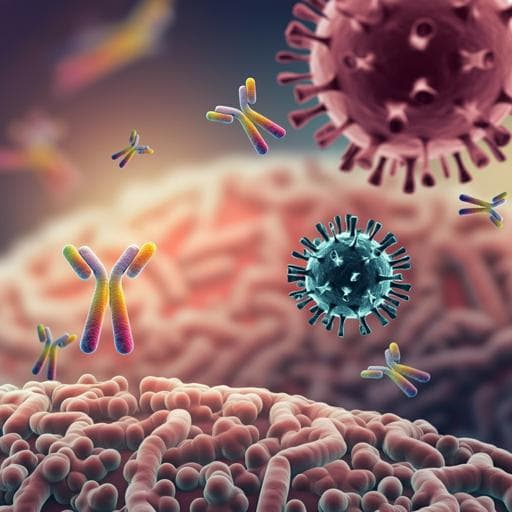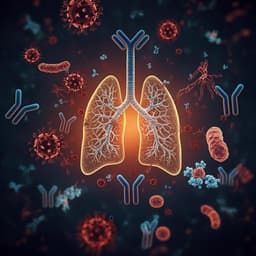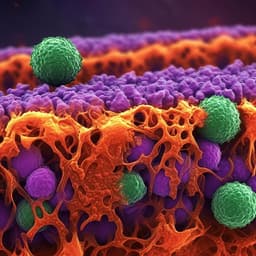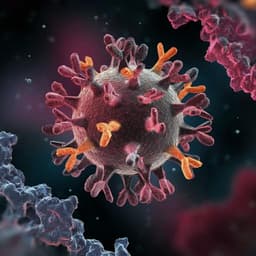
Medicine and Health
SARS-CoV-2 vaccination induces mucosal antibody responses in previously infected individuals
K. Sano, D. Bhavsar, et al.
This study reveals that mRNA vaccination generates stronger mucosal secretory IgA responses in individuals previously infected with SARS-CoV-2, enhancing their post-vaccination immunity. Conducted by a team of experts including Kaori Sano, Disha Bhavsar, and Viviana Simon, the findings are crucial in understanding vaccine efficacy in different populations.
~3 min • Beginner • English
Introduction
SARS-CoV-2 infects respiratory epithelium and causes pneumonia, highlighting the potential importance of secretory IgA (SIgA) at mucosal surfaces in preventing infection. SIgA is produced in mucosal tissues, transported via the polymeric immunoglobulin receptor, and released as multimeric antibodies with a secretory component, often exhibiting higher antiviral activity than monomeric IgA. Prior studies in respiratory infections like influenza suggest mucosal SIgA can be a primary driver of protective humoral immunity in the upper respiratory tract. In COVID-19, IgA responses can arise early and be detected in serum and saliva, and IgA has been found in nasal secretions. However, whether intramuscular mRNA vaccines elicit mucosal SIgA responses remains unclear. This study aims to determine if antigen-specific SIgA is induced following COVID-19 mRNA vaccination and whether prior SARS-CoV-2 infection influences the magnitude and durability of these mucosal responses.
Literature Review
Background literature indicates SIgA provides immediate mucosal immunity by neutralizing pathogens at the epithelial barrier. Multimeric SIgA has enhanced antiviral activity compared to monomeric forms and plays a key role in influenza immunity in previously infected individuals. In COVID-19, IgA responses can precede IgG and are detectable in serum and saliva up to ~40 days post-symptom onset; nasal IgA has also been reported. Prior reports show strong systemic antibody responses after mRNA vaccination, but the extent and determinants of mucosal SIgA induction are variable. Cross-reactive immunity targeting the conserved S2 domain among betacoronaviruses (HCoV-OC43, HCoV-HKU1, SARS-CoV-2) has been suggested, raising the question of whether vaccination might boost pre-existing HCoV-induced mucosal immunity. The present work investigates these aspects, including potential cross-reactivity and the relationship between systemic and mucosal responses.
Methodology
Study design and participants: Longitudinal observational study (PARIS) with paired serum and saliva from 29 adults over up to two years. Eighteen participants (62%) had prior mild SARS-CoV-2 infection (March–April 2020; ancestral strain) and were seropositive before vaccination; 11 (38%) were infection-naïve and seronegative pre-vaccination. All received two doses of either Moderna mRNA-1273 or Pfizer-BioNTech BNT162b2. Demographics were similar between groups. Samples were collected at multiple time points pre- and post-vaccination. IRB approval (IRB-20-0374) and informed consent obtained. Samples stored at −80 °C.
Assays: Serum anti-spike IgG measured by ELISA (plates coated with 100 ng/well recombinant spike; serial three-fold dilutions starting at 1:80; HRP anti-human IgG; OD490 read; background-adjusted; binding curves and AUC calculated). Salivary assays measured anti-spike IgG and SIgA and anti-NP SIgA using ELISAs tailored for secretory IgA detection: plates coated with 100 ng/well antigen; salivary dilutions starting at 1:12 with 1:20 serial; for SIgA, mouse anti-human secretory IgA primary followed by HRP anti-mouse IgG; for IgG, HRP anti-human IgG. OD490 read; blanks used for background adjustment; cut-offs defined as mean + 3 SD of negative controls. Total salivary IgA concentration measured using capture ELISA with anti-human IgA and quantified by five-parameter logistic fit against purified human IgA standard. To account for variability in saliva IgA content, SARS-CoV-2 SIgA signals were normalized to total IgA per sample. Recombinant proteins: SARS-CoV-2 spike, RBD, nucleoprotein (from pCAGGS; Expi293 system; Ni-NTA purification for S/RBD). HCoV-OC43 and HCoV-HKU1 spike expression plasmids used for cross-reactivity studies. Statistical analysis: Mann–Whitney for two-group comparisons; Kruskal–Wallis for three-group/timepoint comparisons; Spearman’s rank for correlations; analyses in GraphPad Prism v9.
Outcomes: Primary—induction and magnitude of salivary anti-spike SIgA post-vaccination, stratified by prior infection status. Secondary—relationships between salivary SIgA and serum IgG, time-course dynamics, anti-NP SIgA (infection marker), and assessment of HCoV (OC43/HKU1) and SARS-CoV-2 S2 cross-reactivity.
Key Findings
- Vaccination induced detectable anti–SARS-CoV-2 spike salivary SIgA in a substantial subset of participants, with more robust and higher responses in those previously infected (seropositive) compared to naïve (seronegative) individuals.
- Time-course analyses showed pronounced peaks in both serum anti-spike IgG and salivary anti-spike SIgA in seropositive individuals after vaccination; seronegatives also showed peaks but with lower magnitudes. Some seronegative individuals mounted appreciable salivary SIgA responses.
- Strong correlation between salivary anti-spike IgG and serum anti-spike IgG (Spearman r=0.8960; p<0.0001) indicates salivary IgG largely reflects serum transudation. In contrast, salivary anti-spike SIgA correlated only moderately with serum IgG (Spearman r=0.5658; p<0.0001), consistent with local mucosal production.
- Group comparisons across time: seropositive individuals had significantly higher mucosal SIgA anti-spike titers before vaccination and remained higher 1–100 days and >100 days post-vaccination compared to seronegatives (selected p-values reported: e.g., for adjusted SIgA AUC comparisons, Pre p=0.0059; >100 days p=0.0215). Serum and salivary anti-spike antibody titers increased significantly after vaccination in both groups.
- Anti-nucleoprotein (NP) SIgA, indicative of infection rather than vaccination, did not increase with vaccination and waned over time in seropositives; differences between groups disappeared >100 days post-vaccination, indicating vaccination did not boost anti-NP SIgA.
- Peak salivary anti-spike SIgA titers were higher in seropositives than seronegatives (p=0.0070). Peak serum anti-spike IgG was also higher in seropositives (p=0.0131).
- Within the seropositive group, individuals classified as SIgA-induced (above cutoff) had higher baseline salivary anti-spike SIgA than non-induced (p=0.0261), suggesting pre-existing mucosal immunity predicts successful SIgA boosting. This baseline difference was not significant in seronegatives (p=0.1775).
- Baseline saliva SIgA and serum IgG levels did not correlate with fold-increase in saliva SIgA after vaccination, whereas higher baseline serum IgG negatively correlated with serum IgG fold-increase by vaccination.
- Cross-reactivity analyses: No significant differences at baseline in salivary SIgA against HCoV-OC43/HKU1 spikes or SARS-CoV-2 S2 between SIgA-induced and non-induced seropositives. S2/RBD binding ratio of peak SIgA did not differ between SIgA-induced seropositives and seronegatives, indicating no skew toward cross-reactive S2. The fold-increase of anti–SARS-CoV-2 spike SIgA with vaccination exceeded that for OC43/HKU1 spikes, supporting the elicitation of SARS-CoV-2 spike–specific SIgA rather than back-boosting of HCoV responses.
Discussion
These findings indicate that intramuscular mRNA vaccination can induce mucosal anti-spike SIgA, particularly in individuals with prior SARS-CoV-2 infection who likely possess pre-existing mucosal memory that can be boosted. The stronger and more persistent SIgA in previously infected participants suggests that hybrid exposure (infection plus vaccination) enhances mucosal immunity. The modest correlation between salivary SIgA and systemic IgG underscores the independence of local mucosal responses from circulating antibodies. Lack of vaccine-induced anti-NP SIgA increases and its waning pattern in seropositives further confirm vaccination specificity for spike. Analyses of HCoV cross-reactivity argue against back-boosting of seasonal coronavirus SIgA as the primary driver of observed responses in naïve vaccinees.
Potential mechanisms for mucosal SIgA induction following intramuscular vaccination include trafficking of activated antigen-presenting cells or antigen-specific B cells to mucosa-associated lymphoid tissues (MALT) where they differentiate into SIgA-secreting plasma cells, or direct antigen access to mucosal sites. While the study did not establish a link between seasonal coronavirus immunity and SIgA induction in naïve individuals, limitations in sensitivity and sample size leave this possibility open. Overall, the results are relevant for understanding how current vaccines contribute to mucosal immunity and for informing strategies to enhance mucosal protection against respiratory pathogens.
Conclusion
Intramuscular SARS-CoV-2 mRNA vaccines can elicit salivary SIgA against spike, with significantly stronger responses in individuals with prior infection. Pre-existing mucosal anti-spike SIgA in seropositives associates with successful boosting post-vaccination. Vaccine-induced SIgA appears spike-specific rather than arising from back-boosted seasonal HCoV responses. These data support the concept that systemic vaccination can contribute to mucosal immunity and highlight the immunological advantages of hybrid exposure. Future work should elucidate the cellular and anatomical mechanisms of SIgA induction by systemic vaccines, assess durability and functional neutralization of mucosal SIgA, and explore vaccine strategies (e.g., mucosal boosters or heterologous platforms) to optimize mucosal protection in infection-naïve populations.
Limitations
- Sample size (n=29) is modest, potentially limiting power to detect associations, including with seasonal HCoV immunity.
- SIgA assays were run once per sample due to limited specimen volumes, which may increase measurement variability.
- Normalization of salivary SIgA to total IgA may be influenced by minor serum IgA leakage into saliva, though estimated to contribute ~10% and considered negligible by authors.
- The exact mechanism of mucosal SIgA induction after intramuscular vaccination was not directly investigated.
- Potential confounding by unrecognized intercurrent infections was mitigated by monitoring anti-NP SIgA but cannot be fully excluded.
- Vaccine type (BNT162b2 vs mRNA-1273) and timing heterogeneity were not powered for subgroup comparative analyses.
Related Publications
Explore these studies to deepen your understanding of the subject.







